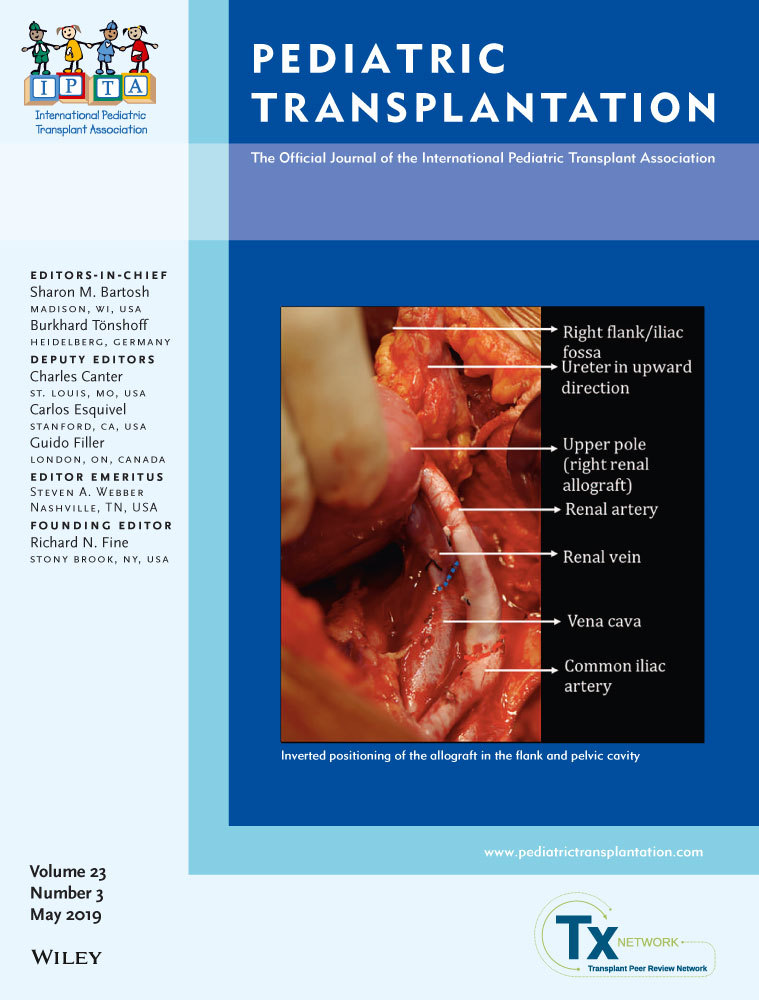Post-transplant metabolic syndrome in children: Know better to cure better
Corresponding Author
Valerio Nobili
Hepatology, Gastroenterology and Nutrition Unit, IRCCS "Bambino Gesù" Children's Hospital, Rome, Italy
Department of Pediatric, University "La Sapienza", Rome, Italy
Correspondence
Valerio Nobili, Hepatology, Gastroenterology and Nutrition Unit, “Bambino Gesù” Children’s Hospital IRCCS (Instituto di Ricovero e Cura a Carattere Scientifico), Rome, Italy.
Email: [email protected]
Search for more papers by this authorAndrea Pietrobattista
Hepatology, Gastroenterology and Nutrition Unit, IRCCS "Bambino Gesù" Children's Hospital, Rome, Italy
Search for more papers by this authorLuca Valenti
Department of Pathophysiology and Transplantation, University of Milan, Milan, Italy
Internal Medicine and Metabolic Diseases, Fondazione IRCCS Ca' Granda Ospedale Maggiore Policlinico Milano, Milan, Italy
Search for more papers by this authorMarco Spada
Division of Abdominal Transplantation and Hepatobiliopancreatic Surgery, Bambino Gesù Children's Research Hospital IRCCS, Rome, Italy
Search for more papers by this authorCorresponding Author
Valerio Nobili
Hepatology, Gastroenterology and Nutrition Unit, IRCCS "Bambino Gesù" Children's Hospital, Rome, Italy
Department of Pediatric, University "La Sapienza", Rome, Italy
Correspondence
Valerio Nobili, Hepatology, Gastroenterology and Nutrition Unit, “Bambino Gesù” Children’s Hospital IRCCS (Instituto di Ricovero e Cura a Carattere Scientifico), Rome, Italy.
Email: [email protected]
Search for more papers by this authorAndrea Pietrobattista
Hepatology, Gastroenterology and Nutrition Unit, IRCCS "Bambino Gesù" Children's Hospital, Rome, Italy
Search for more papers by this authorLuca Valenti
Department of Pathophysiology and Transplantation, University of Milan, Milan, Italy
Internal Medicine and Metabolic Diseases, Fondazione IRCCS Ca' Granda Ospedale Maggiore Policlinico Milano, Milan, Italy
Search for more papers by this authorMarco Spada
Division of Abdominal Transplantation and Hepatobiliopancreatic Surgery, Bambino Gesù Children's Research Hospital IRCCS, Rome, Italy
Search for more papers by this author
REFERENCES
- 1Kasahara M, Sasaki K, Uchida H, et al. Novel technique for pediatric living donor liver transplantation in patients with portal vein obstruction: the "pullout technique". Pediatr Transplant. 2018; 22(8): e13297.
- 2Nobili V, de Ville de Goyet J. Pediatric post-transplant metabolic syndrome: new clouds on the horizon. Pediatr Transplant. 2013; 17(3): 216-223.
- 3Magge SN, Goodman E, Armstrong SC, Committee on Nutrition; Section on Endocrinology; Section on Obesity. The Metabolic syndrome in children and adolescents: shifting the focus to cardiometabolic risk factor clustering. Pediatrics. 2017; 140(2): e20171603.
- 4Dumortier J, Giostra E, Belbouab S, et al. Non-alcoholic fatty liver disease in liver transplant recipients: another story of “seed and soil”. Am J Gastroenterol. 2010; 105(3): 613-620.
- 5Martin P, Di Martini A, Feng S, Brown R, Fallon M. Evaluation for liver transplantation in adults: 2013 practice guideline by the American Association for the Study of Liver Diseases and the American Society of Transplantation. Hepatology. 2014; 59(3): 1144-1165.
- 6Eslam M, Valenti L, Romeo S. Genetics and epigenetics of NAFLD and NASH: clinical impact. J Hepatol. 2018; 68(2): 268-279.
- 7Stender S, Kozlitina J, Nordestgaard BG, Tybjærg-Hansen A, Hobbs HH, Cohen JC. Adiposity amplifies the genetic risk of fatty liver disease conferred by multiple loci. Nat Genet. 2017; 49(6): 842-847.
- 8Dongiovanni P, Stender S, Pietrelli A, et al. Causal relationship of hepatic fat with liver damage and insulin resistance in nonalcoholic fatty liver. J Intern Med. 2018; 283(4): 356-370.
- 9Trunečka P, Míková I, Dlouhá D, et al. Donor PNPLA3 rs738409 genotype is a risk factor for graft steatosis. A post-transplant biopsy-based study. Dig Liver Dis. 2018; 50(5): 490-495.
- 10Miyaaki H, Miuma S, Taura N, et al. PNPLA3 as a liver steatosis risk factor following living-donor liver transplantation for hepatitis C. Hepatol Res. 2018; 48(3): E335-E339.
- 11Dunn W, O'Neil M, Zhao J, et al. Donor PNPLA3 rs738409 genotype affects fibrosis progression in liver transplantation for hepatitis C. Hepatology. 2014; 59(2): 453-460.
- 12Finkenstedt A, Auer C, Glodny B, et al. Patatin-like phospholipase domain-containing protein 3 rs738409-G in recipients of liver transplants is a risk factor for graft steatosis. Clin Gastroenterol Hepatol. 2013; 11(12): 1667-1672.
- 13Valenti L, Rametta R, Ruscica M, et al. The I148M PNPLA3 polymorphism influences serum adiponectin in patients with fatty liver and healthy controls. BMC Gastroenterol. 2012; 12: 111.
- 14Chiu KW, Goto S, Nakano T, et al. Genetic polymorphisms of the hepatic pathways of fatty liver disease after living donor liver transplantation. Liver Int. 2018; 38(12): 2287-2293.
- 15Hilk K, Melissa Zerofsky M, Sue Rhee S, Philip Rosenthal P, Perito ER. Center variation in screening for and management of metabolic syndrome in pediatric liver transplant recipients. Pediatr Transplant. 2018;23(3):1-8.




